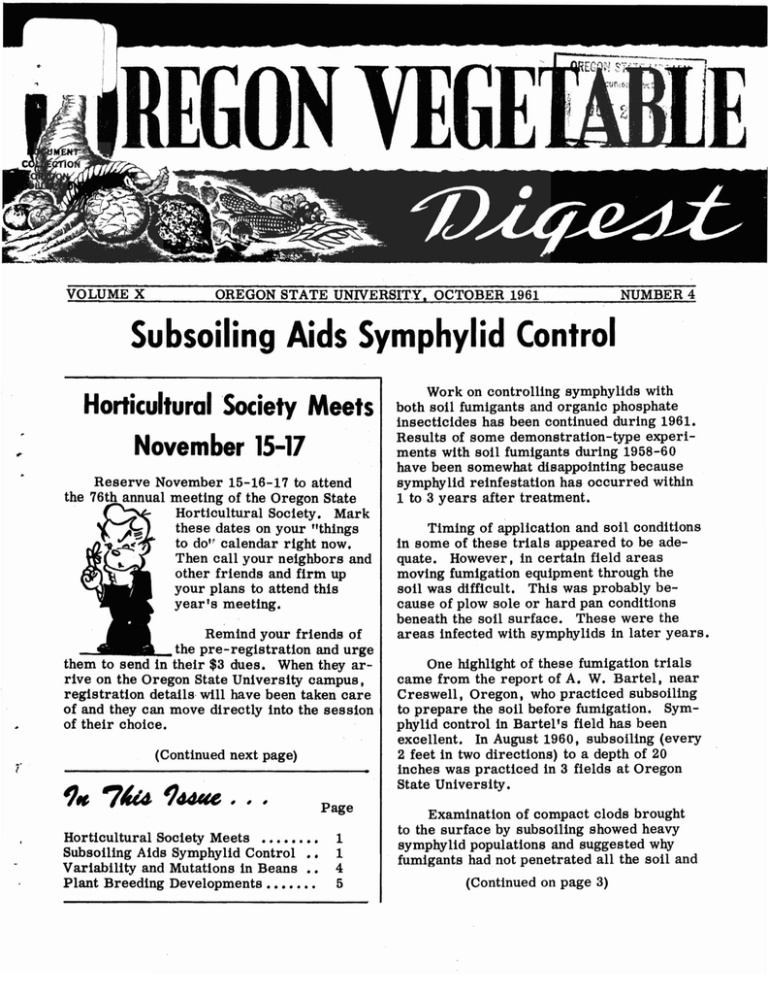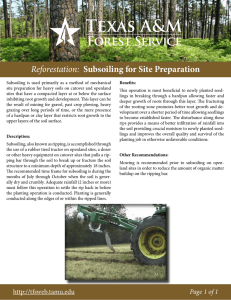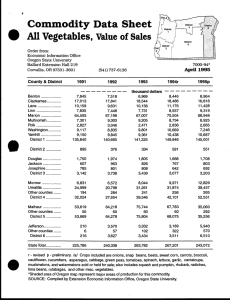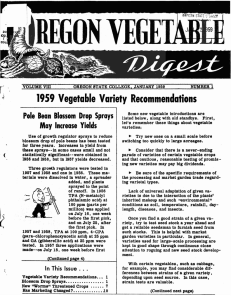Document 13797736
advertisement

VOLUME X OREGON STATE UNIVERSITY. OCTOBER 1961 NUMBER 4 Subsoiling Aids Symphylid Control ".. Horticultural Society Meets November 15-17 Reserve November 15-16-17 to attend the 76th annual meeting of the Oregon State Horticultural Society. Mark these dates on your "things to do'" calendar right now. Then call your neighbors and other friends and firm up your plans to attend this year's meeting. Remind your friends of the pre-registration and urge them to send in their $3 dues. When they ar­ rive on the Oregon State University campus, registration details- will have been taken care of and they can move directly into the session of their choice. r (Continued next page) 1. 7," 'lUta , , , Horticultural Society Meets •••••••• Subsoiling Aids Symphylid Control •• Variability and Mutations in Beans •• Plant Breeding Developments ••••••• Page 1 1 4 5 Work on controlling symphylids with both soil fumigants and organic phosphate insecticides has been continued during 1961. Results of some demonstration-type experi­ ments with soil fumigants during 1958-60 have been somewhat disappointing because symphylid reinfestation has occurred within 1 to 3 years after treatment. Timing of application and soil conditions in some of these trials appeared to be ade­ quate. However, in certain field areas moving fumigation equipment through the soil was difficult. This was probably be­ cause of plow sole or hard pan conditions beneath the soil surface. These were the areas infected with symphylids in later years. One highlight of these fumigation trials came from the report of A. W. Bartel, near Creswell, Oregon, who practiced subsoiling to prepare the soil before fumigation. Sym­ phylid control in Bartel's field has been excellent. In August 1960, subsoiling (every 2 feet in two directions) to a depth of 20 inches was practiced in 3 fields at Oregon State University. Examination of compact clods brought to the surface by subsoiling showed heavy symphylid populations and suggested why fumigants had not penetrated all the soil and (Continued on page 3) 2 Horticultural Society • • • (Continued from page 1) I 1 The four sectional sessions are: Apples and Pears; Stone Fruits; Small FrUits; and Vegetables., The vegetable session will include presentations and disoussions of interest to both the processing and fresh market producer. General sessions will cover topics of interest to all persons engaged in agriculture. A, copy of the complete program will be mailed to all Society members in good standing on October I, but for planning purposes the following schedule should be helpfUl. Wednesday, November 15 12:00 noon--Registration and special luncheons 1 :30 p. m. to 4:30 p. m. --Sectional programs 6:30 p. m. --Activities committee meetings 7:00 p. m. --Kick-off 'dinner Thursday, November 16 8:00 a. m. 9:00 a. m. 10:45 a. m. 12:00 noon 2:00 p. m. 3:15 p. m. 7:00 p. m. --Registration and coffee hour --General session --Sectional programs --Special luncheons and exhibits --General session --Sectional programs --Annual banquet Friday, November 17 8:00 a. m. 9:00 a. m. 10:45 a. m. 12:00 noon --Registration and coffee --General session --Business meeting --Adjourn PREVIEW of general sessions program. Market changes provide opportunities 1. Domestic Market Changes and Opportunities Alden C. Manchester, Head, 'Horticultural Crops Section, Marketing Economics Division, USDA 2. Foreign Market Changes and Opportunities Paul J. Findlen, United States Trade Center, London t England Oregon's Vegetable Digest is published four times a year by the Agricultural Experiment Station, Ore­ gon State University, Corvallis. F. E. Price, Director. Address correspondence to the author concerned or to the Department of Horticulture. Material may be reprinted providing no endorsement of a commercial product is stated or implied. Please credit Oregon State University. To simplify technical terminology, trade names of products or equiprqent sometimes will be used. No endorsement of products named is intend~d nor is criticism implied of products not mentioned. 3 .Horticultural Society • • • (Continued from/page 2 -.-',1 Farmer liability and responsibility as an employer 1. ,ft' The Present Law and How it Works Emily P. Logan, Representative t State Industrial A,ccident Commission 2. The Farmer's Responsibility Kieth Skelton, Attorney, Eugene f Oregon Labor· problems 1. The California Situation John Zuckerman. Stockton, California 2. The Oregon Situation David H. Cameron, Commissioner, Oregon Departme.nt of Employment BA.NQUET speaker The Honorable Mark O. Hatfield, Governor of Oregon This schedule should give everyone ample time to see the OSU campus and to visit with staff members and friends. • A • Subsoiling • • • (Continued from page 1) produced better sympb;ylid control. Three fumigants, Telone, Vidden-D (Dow Chemical Company counterpart of D-D Mixture). and dichlorethyl ether were used in these trials, all at the rate of 30 gallons per acre. Routine symphylid surveys in these fields during 1961 failed to uncover any living symphylids. Crop growth of tomatoes, beans, corn. and other vegetables in the treated soil was outstanding. . Trials with subsoiling before application of soil fumigants, such as Vorlex and D-D Mixture, are now in progress. Results will be available in 1962. Current tests with org·anic phosphate materials VC-13 and Zinophos (formerly designated as 18,133) have been most promising for symphylid control. Emphasis has been placed on obtaining residue and flavor evaluations for many crops grown in soil treated with these materials. Results are not yet available. • • A --H. E. Morrison Entomology Department 4 Induced Variability and Mutations in Beans " Several years ago, through the courtesy of S. Shapiro of the Brookhaven Laboratory in New York, pole Blue Lake bean seeds were gamma irradiated with the hope of producing a mutation of pole to bush. Two generations of the irradiated materials were grown at Corvallis, but no major mutations for growth habit were noted. It was expected that chances for such a mutation were remote, and a program of backcrossing of Blue Lake to a bush (determinate) bean was carried on simultaneously. Theoretically, a persistent program of backcrossing, using Blue Lake as a recurring parent. was expected to transfer the Blue Lake pod to a bush (determinate, or dwarf) type. This goal has been accomplished, for all practical purposes f but the growth habit of OSU bush beans derived by this process is far from ideal. Also, yields have not been con­ sistently satisfactory in experimental plantings through the warm 1961 season. Pod diam~ter weaknesses of earlier selections have·been reduced in later baokcross progeny_ These beans form a new base for hybridization and irradiation. It is no longer necessary to search for a mutation from pole to bush. Attention now can be turned entirely to bush-within-bush progeny. Our main tool--and hope--for improvement of habit lies in the progeny of hybrids which have been made with "true" bush beans, especially Tendercrop. Yet the problem is of such importance that another stUdy of irradiated material seemed justified. In the spring of 1961 f therefore. Be 7 seeds of OBU bush types were irradiated at Brookhaven (Dr. Shapiro has since joined the staff of the University of Oregon) , and t4e second generation (R2) seeds are being harvested for planting in 1962. They will be screened especially for any improvement in upright, stiff growth habit. It is sometimes questioned whether irradiation to induce mutations is effective and practical. It was shown as long as 35 years ago that irradiation would speed up mutations-­ most of which are undesirable in both plants and animals. Desirable mutants have been reported elsewhere in barley, mustard, rape t and beans. Research for resistance to certain diseases in cereals, through irradiation and subsequent mass screening of seedlings, has also been effective. Other mutagenic agents may be used--certain chemicals, as well as X-rays, for example, but extensive use of these techniques is not contemplated in our work. Our major emphasis in the immediate f~ture will be placed on segregating progeny in which naturally-induced vari­ ability (for growth habit and pod refinement) has been obtained by hybridization of OSU bush beans with upright types. Progeny of F2; F3, and 'F4 generations from these crosses will be available in 1962. Greenhouse screening of ~8 many selections as possible will pe carried out this winter. The recovery of all of the pod refinements of the Blue Lake pole bean from such crosses, while -maintaining growth habit as desirable as that of Tendercrop. must con­ tinue to be recognized as a major problem in bean improvement. There is also a need for increased emphasis on observation of large numbers of· individual plants grown in the field. A study of bush-within-bush growth habit is 'currently under way by David Davis J graduate student in Horticulture. --w. A. Frazier, J. R. Baggett, H. J. Mack Department of Horticulture --W. A. Sistrunk Department of Food and Dairy Technology ••• 5 Plant Breeding Developments Reported " Extensive interest and activity in the field of vegetable improvement through plant breeding is apparent in the Proceedings of the American Society for Horticultural Science. Several articles from volumes 76 and 77 related to plant breeding have been reviewed and are summarized very briefly here.' Many studies reported pertain to the techniques employed and the continual search for new plant characteristics. In some cases new characteristics are of value only because they facilitate breeding or seed production procedures. For example, male-sterility is of great value in the production of Fl hybrids and is used for that purpose in tomatoes. onions, and corn. Male-sterile cucumbers have been observed for many years f but have not produced seed, according to W. C. Barnes of South Carolina. Barnes reported the discovery of seed producing male-sterile plants. Work on the genetics of male-sterility and on the pro­ duction of lines for Fl hybrid production is under way. The same author reported the development, in South Carolina f of cucumbers resista.nt to anthracnose, downy mildew, powdery mildew, mosaic, and scab. A cold unit system of screening carrots to eliminate the annual or bolting habit was described by M. H. Dickson et al. in Michigan. Approximately 650 hours below a base of 500 are necessary during the first 2 months for adequate flower induction, followed by a period of about 3 months for the development of all potential seedstalks. An important part of this research was the determination of a base temperature. Three years of research showed that soil surface temperature was the best criterion, and that 55 0 F. was considerably less effective than 50o F. as a base. . Paper chromatography was used by Singh and Thompson to determine differences in . flavonoids in vegetable varieties. Using this method, which has considerable potential in the isolation of plant components. it was possible to show that certain individual varieties could be identified by their particular chromatographio pattern, while other varieties fell into groups of various size. For example, bean varieties Florigreen, Extender, Cornel114, and Pinto could be identified individually, while nine remaining varieties were placed in. two groups. Such work suggests the possibility of using ohromatography to locate plants having known desirable components after hybridization. or in the simple identification of varieties. Mann and McFerran in Arkansas, who consider color to be the most emphasized quality factor in tomatoes, studied the inheritance of dark red fruit color from Lycopersicon pimpinellifolium, one of the wild species often used in breeding programs. They reported that the inheritance of dark color was multigenic and perhaps very complex. There was also a slight indication that dark red fruit color might be associated with small fruit size. Varietal differences in Beta carotene content of winter squash varieties was studied by Hopp, Merrow, and Elbert of Vermont. Beta carotene, the precursor of vitamin A, was less abundant in all varieties at harvest and increased during the first 10 weeks of storage. The six varieties studied, in order of their carotene content, were Baby Blue, Buttercup, Butternut, Blue Hubbard, Silver Bell, and Sweet Meat• ••• 6 U'eed ~ 1I«e/ -~ ) Solan, N-(3-chloro-4-methylphenyl)-2-methylpentamide, has recently been registered for use for chemical control of weeds in tomatoes. This herbicide is effective in controlling a wide range of broadleaf and grass weed species. Tests at CONa11is indicate that timing in relation to weed development is highly critical for maximum control. Label recommenda­ tions specify application after weeds have emerged but before broadleaf weeds exceed 2 inches in height or annual grasses 1 inch in height. Although tomatoes exhibit considerable tolerance for this chemical, some sensitivity' is apparent at the time of emergence of seeded tomatoes or when transplants are recovering from the shock of field setting. For this reason it is recommended that Solan not be applied within 2 weeks of transplanting. Seeded tomatoes can be treated at a delayed pre-emergence timing or after the plants have reached 6 inches in height. 1I~1I«e/ Sacklin, Kyle, and Wolford of the Puyallup, Washington, Experiment Station f found that soluble solids measurements were an effective method of predicting the moisture content of sweet corn. The measurements were found to be similar enough for two seasons in their area to be of practical importance in a variety testing program. Harvest of simi­ lar moisture samples makes possible a better varietal testing program utilizing direct comparisons of field characteristics, yields, percent cut corn. and samples for processing and sensory evaluations. (Proc. Amer. Soc. Hort. Sci. 1§., 1960.)





